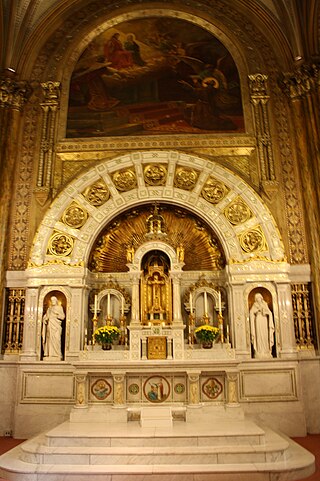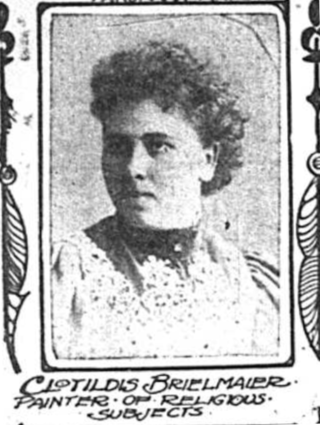
The Basilica of Saint Hyacinth is a historic church of the Roman Catholic Archdiocese of Chicago, located at 3636 West Wolfram Street in the Avondale neighborhood of Chicago, Illinois.

Calvary Cemetery is the oldest existing Catholic cemetery in Milwaukee, Wisconsin. Owned by the Archdiocese of Milwaukee, it is the final resting place for many of the city's early influential figures. The cemetery was designated a Milwaukee Landmark in 1981.

Saint Mary of the Angels is a historic church of Roman Catholic Archdiocese of Chicago in Chicago, Illinois.

St. Adalbert Church is a historic church of the Roman Catholic Archdiocese of Chicago. The church is located on 17th Street between Paulina Street and Ashland Avenue in the Pilsen neighborhood of Chicago, Illinois. St. Adalbert has served generations of Polish immigrants and their American-born children; at its peak, parish membership numbered 4,000 families with more than 2,000 children enrolled in the school. Today, the church is an anchor for the Mexican immigrants that have made the Pilsen area their home.
SS. Cyril and Methodius in Lemont - historic church of the Roman Catholic Archdiocese of Chicago, located in Lemont, Illinois.

Tadeusz Żukotyński was a Polish count, professor, and painter.
Sister Mary Stanisia, SSND, was an American Catholic nun, artist, and painter, member of the School Sisters of Notre Dame.

Erhard Brielmaier was an architect in the United States and Canada from the late 19th century through the early 20th century. He designed and built more churches and hospitals than any other architect.

St. Hedwig's Church is a historic parish church of the Roman Catholic Archdiocese of Chicago located in Chicago, Illinois. Constructed in the grand Polish Cathedral style, it is one of the many monumental Polish churches visible from the Kennedy Expressway. The church is located at 2226 North Hoyne Avenue.

The Church of the Immaculate Conception, referred to in Polish as Kościół Niepokalanego Poczęcia Najświętszej Maryi Panny, is a historic church of the Roman Catholic Archdiocese of Chicago located at 2944 East 88th Street in Chicago, Illinois. It is a prime example of the so-called 'Polish Cathedral style' of churches in both its opulence and grand scale. Along with St. Michael's, it is one of the two monumental Polish churches dominating the South Chicago skyline.

Holy Innocents Church,, is a church of the Roman Catholic Archdiocese of Chicago located at 743 North Armour Street in the East Village neighborhood of Chicago, Illinois. It is a prime example of the so-called "Polish Cathedral style" of churches in both its opulence and grand scale.

St. Michael is a church of the Roman Catholic Archdiocese of Chicago. The current church is located at E. 83rd Street and S. South Shore Drive in South Chicago, a neighborhood of Chicago, Illinois.

Saint John Cantius Church is a Latin Catholic church of the Archdiocese of Chicago.
Bernard Otto Gruenke was an American stained glass artist who produced one of the first faceted glass windows in the United States in 1949. He was born in Sheboygan, Wisconsin.
Lincoln Village is a south side neighborhood within the City of Milwaukee.

The Church of the Immaculate Conception on the motherhouse grounds of the Sisters of Providence of Saint Mary-of-the-Woods is a large Italian Renaissance Revival-style church constructed of Indiana limestone at Saint Mary-of-the-Woods, Indiana. The cathedral-like structure, which is the fourth church/chapel of the Sisters of Providence since their arrival at Saint Mary-of-the-Woods in 1840. Construction for the church began in 1886; its exterior was completed in 1891 and the interior was completed in 1907. The church was consecrated on October 23, 1907, and continues to serve as a place of daily worship services that are open to the public. The church also houses the shrine and tomb of Saint Mother Théodore Guérin, foundress of the Sisters of Providence of Saint Mary-of-the-Woods. Our Lady of Sorrows Chapel (1905) was erected in the crypt beneath the church.
Gonippo Raggi was an Italian artist who provided murals for many churches and church institutions in the United States.

St. George Melkite Catholic Church is a Melkite Greek Catholic Church, located in Milwaukee, Wisconsin. It was added to the National Register of Historic Places in 1986. The church was built in 1917 to serve the needs of the Syrian-Lebanese community who migrated to Milwaukee after the Chicago World's Fair of 1892. It is the second oldest Melkite church in the United States.

St. Catharine Church is a Catholic church in Spring Lake, New Jersey, used by the Parish of the St. Catharine & St. Margaret in the Diocese of Trenton.

Clotilde Elizabeth Brielmaier, sometimes called "Lottie" Brielmaier, was a German-American religious painter, specializing in portraits and church murals. She was the daughter of the famous Milwaukee architect Erhard Brielmaier and often collaborated with her family members on projects. She spent several years, as many as twenty, studying at the art centers of Europe including Munich and Rome. She is said to be the first female artist to establish her own studio in the United States, which was located in the now demolished University Building in Milwaukee, Wisconsin.


















